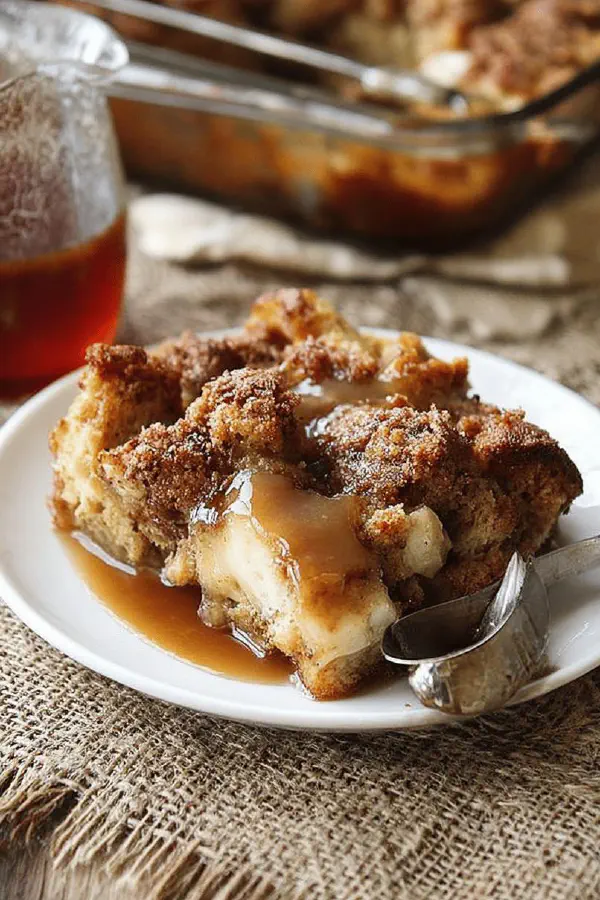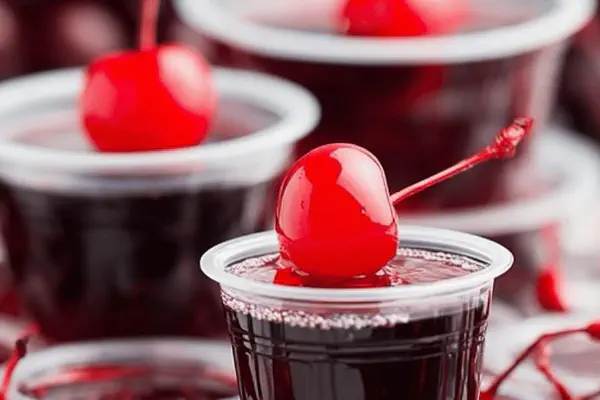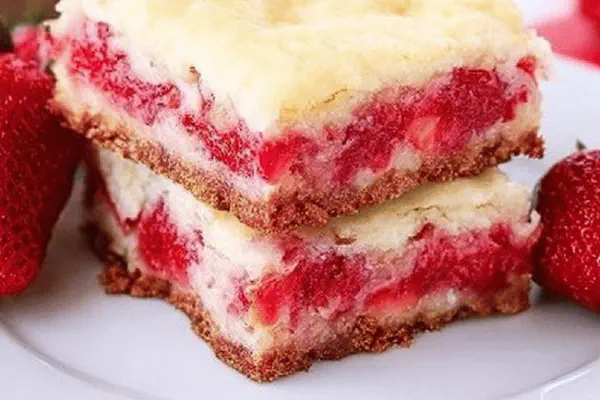Featured Recipe
Twisted Bread Pudding

By Kate
"
Custard soaked cubed ciabatta, baked low and slow with cinnamon and maple syrup. Brown sugar topping caramelizes to a crackly crust. Vanilla swapped for cardamom. Half-and-half replaces cream to cut richness. Eggs reduced slightly. Sauce uses coconut milk and a splash of bourbon for warmth. Soak overnight for deep flavor penetration. Visual cues guide doneness—wiggly center, golden edges. Avoid soggy, dense texture by draining excess custard before baking. Sauce thickens on cooling, pouring while warm. Serve just cooled so sauce seeps in but pudding retains structure.
"
Prep:
40 min
Cook:
50 min
Total:
Serves:
12 servings
bread pudding
desserts
American cuisine
Introduction
Custard soaked bread cubes waiting in the fridge. Overnight soak is key—starch swells, flavors meld. Ciabatta crust fights sogginess better than soft baguette. Maply syrup and cardamom swap out from classical vanilla-cinnamon combo. Bread pudding needs low oven heat to set center without drying edges; waggle test essential here. Brown sugar topping melts and caramelizes to a crunchy crust, contrast with moist center. Sauce thickens as it cools—warm it before pouring, let it soak in slowly. Bourbon optional. Kitchen smells heady with cinnamon. Watch timing closely; every oven varies. This is show-don’t-tell baking—feel texture, look for jiggle, not just minute counts.
Ingredients
About the ingredients
Swapping classic cream for half-and-half saves on heaviness, less risk of greasy pudding. Cardamom replaces vanilla for a fresher aromatic punch—use ground or crushed pods for more bite. Ciabatta preferred over baguette due to firmer structure—no mush at the bottom. Brown sugar topping encourages caramelization—don’t skip or substitute with white sugar, the moisture content differs radically. Bourbon in sauce optional, brings warmth; non-alcoholic options include vanilla or espresso extract. Use fresh eggs for best custard texture—older whites can cause weeping. If ciabatta unavailable, sturdy sourdough works fine but adjust soaking time to prevent chewing too dense. Drain excess custard to avoid puddles that create soggy texture; keep some moisture but not a bath.
Method
Soak preparation
- Whisk half-and-half, eggs, white sugar, cinnamon, cardamom, maple syrup and vanilla until smooth and frothy in a large bowl. No clumps—mix thoroughly. Use large enough bowl so bread can soak freely. The switch from cream to half-and-half trims fat, prevents pudding from feeling too heavy.
- Cut ciabatta lengthwise to avoid too-thick chunks; then 1-inch cubes. Cube size matters; too small disappears, too big prevents sinking. Gritty crust on ciabatta soaks up custard better than soft baguette crust.
- Transfer bread to custard and push down slightly to submerge most pieces, but don't drown them. Cover with plastic wrap and refrigerate overnight, at least 8 hours. Overnight soak lets starches swell, custard penetrate deep, flavor marry fully.
- Heat oven to 320°F. A bit lower than usual—slower set, less risk of scorched edges with custard-heavy dishes. Spray 9x13 casserole with nonstick spray or butter well to prevent sticking; you want clean removal and defined edges.
- Gently lift soaked bread with slotted spoon or hands. Don't dump custard liquid back in—that puddle causes soggy bottom. Dispose of extra liquid or use for other custards or sweet baked oatmeal. Layer bread evenly in dish, leaving 1/2-inch gap at top so it can puff while baking.
- Spread brown sugar evenly on top; sugar forms caramelized crust in oven. Place dish in oven, bake 50 minutes. Do not rely on timer alone—watch for jiggle in middle that stops, edges deep amber and pulling away slightly from sides. Insert knife in center—if it comes out clean or just moist, it’s ready.
- Meanwhile, melt butter in small heavy saucepan over medium-low heat. Swirling butter bubbles, smells nutty. Add dark brown sugar stirring constantly until bubbling, about 2 minutes. Careful not to burn; too high heat ruins flavor.
- Pour in coconut milk, stir until sauce is smooth and slightly thickened. Let mixture come to gentle boil, then lower heat to simmer 3 minutes. Turn off heat, stir in bourbon if using for smoky depth.
- After taking bread pudding out, let cool 15 minutes uncovered. Pudding firms up, edges crisp while center remains moist. Pour warm sauce slowly over top. It will seep down, soaking into crevices without making pudding soggy. No need to drown entire dish. Save rest for adding later if needed.
- Serve warm or room temp. Pudding may be reheated with extra sauce on top for second day. For substitution: ciabatta replaced with crusty sourdough; cardamom replaced with nutmeg for different aromatic profile.
- If pudding comes out too wet or custardy, reduce soaking time next time or drain better. If dry or dense, increase custard ratio slightly or soak longer. Low oven temp essential to avoiding curdled or burnt edges while ensuring center cooks through. Timing varies by oven—trust wobble test. Sauce thickens on cooling; warm gently before pouring for easy spreading.
- Brown sugar on top can burn quickly if oven too hot or rack too close—watch closely last 10 minutes.
- Use half-and-half or whole milk to adjust richness; heavy cream sometimes too fat-heavy, leaves greasy residue.
- For non-alcoholic sauce omit bourbon, add vanilla or coffee extract for flavor layer.
Baking
Sauce
Serving
Common pitfalls and fixes
Technique Tips
Mix custard well to prevent egg clumps—whisk briskly until smooth, a few bubbles on surface signals aeration. Chop bread into even cubes for uniform soaking and baking. Soak overnight minimum eight hours covered—shorter soak yields uncooked crumbs inside; longer just better infusion. Removing excess custard before baking prevents pudding from becoming wet mush. Spread brown sugar evenly, no clumps to ensure even crust. Bake at moderate 320°F to prevent cracking or over-browning edges, watch last 10 minutes closely—golden hue and jiggle in center are your signals to pull the pan. Sauce layer forms rich sweet layer but watch heat when cooking sugar-butter mix to avoid burning; low heat best. After baking, cool 15 minutes uncovered—too hot, sauce won’t stick; too cold, pudding turns dense and sauce pools. Warm sauce before pouring helps absorption, but do not soak fully or pudding can lose structure. Cooling leftovers firm pudding nicely for easy slicing and reheating.
Chef's Notes
- 💡 Soak bread overnight. Let custard absorb well. Starch swells overnight. Bigger cubes for better soaking; smaller may dissolve. Keep it in the fridge.
- 💡 Oven temp matters; keep it lower. Goldening edges without drying out the center. Check the jiggle test. Not too firm, not too runny. How it feels is key.
- 💡 Brown sugar topping—don't use white. Brown caramelizes better, adds depth. Watch closely; high heat burns quickly. Spread evenly to avoid clumps.
- 💡 Coconut milk for sauce brings flair. Needs a gentle boil, then simmer. If it thickens too much while cooling, heat gently. Stir to reincorporate.
- 💡 Substitutions possible. Sourdough works in place of ciabatta, just adjust soak time. Cardamom? Nutmeg also fits. Alter to suit your taste. Explore flavors.
Kitchen Wisdom
Pudding comes out too wet?
Examine soaking time—reduce it. Less custard might help too. Drain well before baking for better texture.
What if texture turns dry?
Increase custard ratio next time. Soaking longer can also fix issues. Maybe check oven temp settings.
How long can I store leftovers?
Keep in the fridge for days. Freezing works too but texture changes, maybe mushy. Always reheat gently.
Sauce thickened too much?
Add a splash of coconut milk when reheating. Stir frequently. Ensure it doesn’t burn on low heat.



